 Leading Blog | Posts by Month |
 Leading Blog | Posts by Month |
11.30.15

LeadershipNow 140: November 2015 Compilation
See more on
Posted by Michael McKinney at 03:36 PM
11.17.15

Leadership BS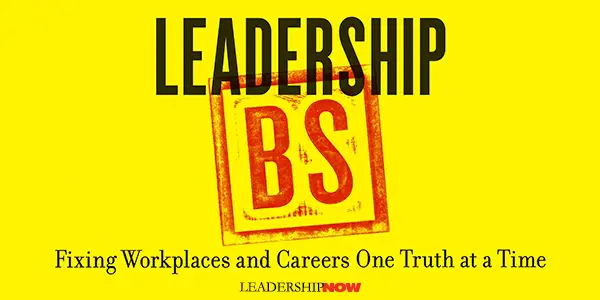
Leadership BS by Jeffrey Pfeffer, is a very important book. It actually builds on the ideas and thinking presented in his classic book written with Bob Sutton, The Knowing Doing Gap over a decade ago. Pfeffer wants to know why, in spite of the thousands of leadership books, blogs, and seminars, are there so many leadership failures? Pfeffer believes that the answer is to be found in the systemic processes that produce leaders who often behave differently from what most people might like or expect. He’s right. As a society, we produce and reward leaders who think short-term, and this is at odds with what it takes to get the leaders we think we want. As we look around there are disconnects between: • what leaders say and do,
It’s not surprising that students of leadership often become disillusioned upon entering the workplace. Life rarely adheres to the good leader formula of success they have come to know. Leadership BS is a compendium of human nature. It describes well the hypocrisy in all of us. We don’t always meet our own standards. We don’t always reward what we say we value. The real world doesn’t behave as it should. These are life issues as much as they are leadership issues. Consider the following comments from Leadership BS: Once people believe they are better leaders—possibly because they have given talks or written about positive leadership, have attended lots of leadership trainings, or because they were once acknowledged for their good leadership—they are less likely to be as vigilant about their subsequent behavior, having already demonstrated their leadership credentials. And finally, this would seem to be a fairly typical experience. Pfeffer was asking a woman who was being outmaneuvered by a peer how she responded to the whole thing: She said that she responded by using her learning and ideas from a leadership course on personal dynamics, colloquially referred to as “touchy-feely,” to attempt to repair the relationship with her peer. “Why?” Pfeffer asks. “Because I have been taught to build relationships of authenticity and trust at work.” But it didn’t work because the peer was not interested in “repairing a relationship” or behaving with trust and authenticity; he was interested in taking over her team for his own advantage. Pfeffer comments: People not only have problems in their current positions, but they also lose out on attractive job opportunities by believing in the prescriptions so frequently proffered for how leaders should behave. The leadership values aren’t the problem. It really becomes a “why” problem for each individual. Why do I believe what I believe? What kind of person do I want to be and why? How important is it to me to be this kind of person, and why? The fact is, you are going out into a world that doesn’t work the way it “should.” People are not always trustworthy, authentic, honest, supportive, generous, or any number of other highly regarded values. If you want to adhere to them you need to understand that the playing field isn't level. Not all organizations encourage virtuous behaviors. Frequently, people do what works for them in the moment to get what they think they want now. It’s short-term thinking, but for many, it seems to work. Leadership BS reads a bit like the book of Ecclesiastes. Solomon illuminated some of the same issues almost 3,000 years ago. He noted that “When the sentence for a crime is not quickly carried out, people’s hearts are filled with schemes to do wrong.” (I wonder if Pfeffer peruses Ecclesiastes in the quiet moments.) Organizations that tolerate less-than-virtuous behavior will get less-than-virtuous behavior. Machiavellian values would not still be circulating almost 500 years after they were first published if they did not “work” in the real world. They do, and quite spectacularly at times. So I have to ask myself, “What is most important to me?” knowing that I may not get some of the things I want out of life if I stick to my values. It is a commitment issue. Values are personal and they stand up to whatever is happening around you. If they don’t they’re not values. They’re strategies. Strategies change when conditions change. Some people will argue that “I’ll temporarily trade my values in on a bigger prize and then I’ll go back to them after I get what I want”—the corner office for instance. Sometimes they do and sometimes they don’t. Either way, there’s always a price. It’s a question of character. It is the same problem faced by schoolchildren every day: Do I compromise my values to get along, to be accepted, or to be promoted to the head of the line? Narcissistic people often get the spotlight as Pfeffer noted. This can be confusing if a person doesn’t have the support structure to navigate human nature. We need to get better at building character from day one. Leadership begins in the home. Pfeffer chides the leadership industry for focusing too much on inspiration and not enough on the reality of the world in which we live. And he is right. Inspiration is important as people need a vision, but there needs to be accountability along the way. The leadership industry is so obsessively focused on the normative—what leaders should be doing and how things ought to be—that it has largely ignored asking the fundamental question of what actually is true and going on and why. Unless and until leaders are measured for what they really do and for actual workplace conditions, and until these leaders are held accountable for improving both their own behavior and, as a consequence, workplace outcomes, nothing will change. He’s talking about creating accountability for what we say we value. Character is a long-term, life-long issue. Do you always stick to your beliefs even when you might lose in the moment for doing so? Fred Kiel demonstrates there is a long-term payoff for doing the right thing in his book Return on Character. The problem we all face in the short-term is that not everyone is playing by the same rules. This isn’t a problem that is ever going to go away. We are all human and will continue to be human. We do need to work on ourselves but it is also an organizational problem. As Pfeffer and Sutton write in The Knowing-Doing Gap: “Some organizations are consistently able to turn knowledge into action and do so even as they grow and absorb new people and even other organizations.” The difference between organizations that do and organizations that don’t comes “more from their management systems and practices than from differences in the quality of their people.” The leadership industry certainly could do more. Knowing without doing leads nowhere. 
Posted by Michael McKinney at 09:49 PM
11.11.15

A Framework of Organizational Tensions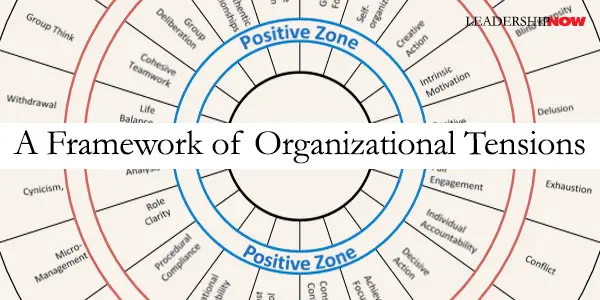
TENSIONS are objectives that seem to be in conflict. They are values that seem to be in opposition. We often treat them as either/or choices when they should be treated as both/and dynamics. Each value or characteristic supports and even makes possible the competing value. Robert Quinn has produced a valuable tool for understanding this concept in his book The Positive Organization. What makes it especially valuable is that it illustrates the options we have to the single values we hold so dear—there are possibilities and equally effective “right” solutions we can use to move us forward. We tend to focus on the value that resonates most with us or the ones we are most familiar with. This often causes us to get stuck or to jump from one ditch to the other never realizing the true potential of our organization. (This dynamic plays out in our personal lives as well.) 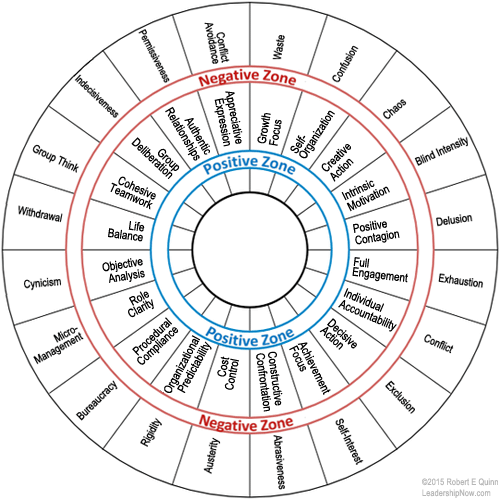 You will notice that each of the positive values in the inner circle is associated with a negative value on the outer circle. If we champion one value over another we put our organizations at risk for the negative outcomes associated with each of the 20 values on the diagram. Every positive value without its contrasting value can become a negative in much the same way the overuse of a strength becomes a weakness. For example, we need some predictability and control in any organization, but too much leads to rigidity. We also need some spontaneity and self-organization for people to flourish, but again too much can lead to organizational and personal chaos. We also miss the larger picture and usually misinterpret issues.  A person who seeks a predictable, smooth running organization often focuses on disruptions and disruptive influences; the natural inclination is to fix those disruptive problems. When we focus on a problem, we are not seeing the whole system. We are paying attention to something within the system. Likewise, when we focus on a single person, we are not focusing on the culture of which that person is a part.When we have an agenda we tend not to see the whole picture. As leaders we need to see the broader context of every situation. It’s not about finding balance. It’s about emphasis—where to place the emphasis and when. Of Related Interest: 
Posted by Michael McKinney at 04:45 PM
11.05.15

What Gear Are You In Right Now?
“Wherever you are, be all there!” Jim Elliot’s advice offers a difficult challenge. “You’re here but your mind is somewhere else” is a common refrain. Jeremie Kubicek and Steve Cockram, authors of 5 Gears: How to Be Present and Productive When There Is Never Enough Time, write “Every day, millions of people are negatively impacted by the inability of a person to connect appropriately and to be present.” So much drama is created when we don’t know how to shift gears and become present. 5 Gears offers an extremely valuable metaphor for identifying which gear you are in and finding the right gear at the right time in order to connect fully with others. The model is a relationship-driven approach. It is values-driven and helps to counteract self-absorption. The majority of people are not aware of their social awkwardness and give little time to thinking about what gear the other person is in while they are talking.What I like most about the 5 Gears model is first, it gives you language to communicate which gear you are in to yourself and others, and to understand where others are at so that you can be more fully present. Second, it helps you plan what gear you need to be in as you move through your day. And third, it helps to be more self-aware and other-aware. 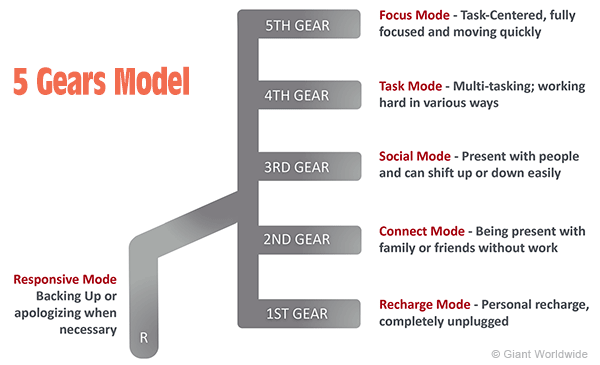 Like shifting gears in a car, there is a right order and a right time for each gear. Life goes more smoothly when you are shifting through the gears at the right time—and avoiding getting stuck in any one gear. Here are the 5 Gears:  5th Gear: Learn to Get "In the Zone" 5th Gear: Learn to Get "In the Zone"5th Gear is focus mode that allows us to “get in the zone” without interruption. It takes discipline to shut the door, turn off your email, and let people know that you are shifting into 5th gear, but it makes it possible to cruise at a sustained speed for a period of time. The caution is that when you get stuck in 5th gear you miss out on relationships, opportunities to add value, and events in life that matter in the long term.  4th Gear: Leading in a Task World 4th Gear: Leading in a Task World4th Gear is the task gear that allows us to work hard while also multitasking. Most of the time we operate in 4th Gear so we need to learn to use it well. Waking up in 4th Gear is not the best strategy for your life. Our tasks can begin to control our lives. (Do you normally check your e-mail when you first wake up?) We need to learn how to shift into it and how to shift out of it. They relate the observation of Elizabeth Paul as an example. How many of us are like this: The personal story for me was realizing that as a woman I have “work” 4th and 5th gear and “domestic” 4th and 5th gear. I thought that because I was being disciplined about putting my devices away during the golden family window of 5 to 8 P.M. I wasn’t in 4th or 5th gear, when in reality I was just putting on a different task hat. When my eyes were opened to that, I realized that I actually have little to no 3rd or 1st gear in my life at all. That was shocking.In other words, the other gears are not just another 4th Gear task. Each Gear requires a different mindset or approach to your time. If we learn to implement the other gears in our life we will find that our everyday, multitasking 4th gear will become more productive.  3rd Gear: Why Being Social Matters 3rd Gear: Why Being Social Matters3rd Gear is the social gear. 3rd gear is a mindset. It is the space between task-driven, hyper focused work and the no-work, relational connection of being with your family, spouse, or close friend. Type-As need to remember that business happens in 3rd gear—in relationships. If you are too important for small talk, you might want to study the chapter on 3rd Gear. Of course you can get stuck in 3rd gear and overdo it. At the same time if you try to control social space it actually becomes a 4th Gear activity for you.  2nd Gear: Connecting Deeply 2nd Gear: Connecting Deeply2nd Gear represents connecting with family, friends, or colleagues. Whether work colleagues, family, or friends, it is time geared toward relationship building without an agenda or pressure to be productive. Some of us have never really learned how to connect. It can’t be forced. It requires making time and learning to truly give of yourself to others. 2nd Gear is a difficult gear to be in because we live in a 4th Gear world. Kubicek writes that while writing this book consumed a lot of time, energy and mental thought, “it is still my responsibility to be the leader worth following in my home. Even with the pressure of a deadline, I still have to practice shifting.” He has found that being present in 2nd Gear leads to healthy relationships that bring peace to your mind and heart, fruitful growth between people, better conversations, likeability and trust, reestablished priorities, less drama and more security, social awareness and emotional intelligence.  1st Gear: Learn How To Recharge 1st Gear: Learn How To Recharge1st Gear represents being fully recharged. Do you know how to recharge? “If you figure out what 1st Gear feels like for you and discipline yourself to spend more time there, more power will flow through you. If you live and lead out of 20 percent battery life then you will never experience what you hope to experience.” The recharging gear if different for all of us. What works for one may not work for another. But we need to find what works for us. Think about this statement: “Working from your rest, not rest from your work, is the goal.” Note to self: “Crashing is not resting; it is actually just crashing.” It is simply stalling out. Truly healthy rest restores you.  Reverse: Learn How to Apologize Reverse: Learn How to ApologizeReverse is the responsive gear. It is used when we need to back up and start again or apologize. Unfortunately, too many people operate without a reverse gear. There are two types of people—responsive and resistant. You hire responsive ones and fire the resistant. Responsive people are self-aware and have a consciousness that is not steeped in victim mentality, but rather responsibility. They understand that they are responsible for their actions and will make amends when they have clearly overstepped their bounds. Responsive people are the best employees, and spouses, and children.Are there any relationships you need to restore? Making the 5 Gears Work For You After explaining the 5 gears, Kubicek and Cockram ask us to find our go-to gear. Where do we like to spend most of our time and what gear is the hardest for us to be in? Learning how to improve on your hardest gears hold the keys to improving your influence in the lives of others. Next you need to find the right time for each gear as you go through your day. There is a natural time for gears. Your mornings should not start in 4th Gear. Really! When we are in the wrong gear at the wrong time we create disconnects. Shifting well is both an art and a science. 5 Gears offers some practical examples of leading your life intentionally and in the right gear at the right time. I know this post is getting long, but let me leave you with an example of integrating the 5 Gears into your daily schedule: 6A.M.—Wake Time: 1st Gear 
Posted by Michael McKinney at 11:28 AM
11.02.15

5 Leadership Lessons: Lessons in Leadership and Life from a Championship Season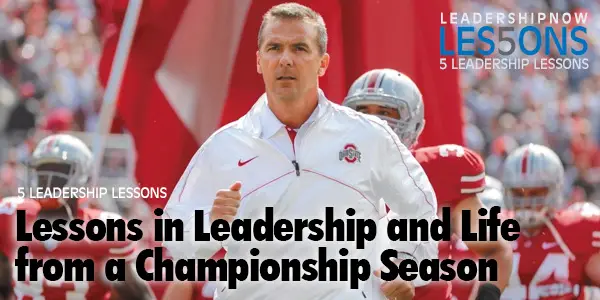
URBAN MEYER is an elite college football coach and currently the head football coach of the Ohio State Buckeyes. In Above the Line Lessons in Leadership and Life from a Championship Season he presents the lessons he has learned over his career. Meyer says, “A leader is someone who earns trust, sets a clear standard, and then equips and inspires people to meet that standard.”

Posted by Michael McKinney at 10:37 PM
11.01.15

First Look: Leadership Books for November 2015Here's a look at some of the best leadership books to be released in November.




For bulk orders call 1-800-423-8273  Build your leadership library with these specials on over 100 titles. All titles are at least 40% off the list price and are available only in limited quantities. “What is reading but silent conversation?” — Walter Savage Landor
Posted by Michael McKinney at 09:34 AM
|
BUILD YOUR KNOWLEDGE


How to Do Your Start-Up Right STRAIGHT TALK FOR START-UPS 
Grow Your Leadership Skills NEW AND UPCOMING LEADERSHIP BOOKS 
Leadership Minute BITE-SIZE CONCEPTS YOU CAN CHEW ON 
Classic Leadership Books BOOKS TO READ BEFORE YOU LEAD |
|